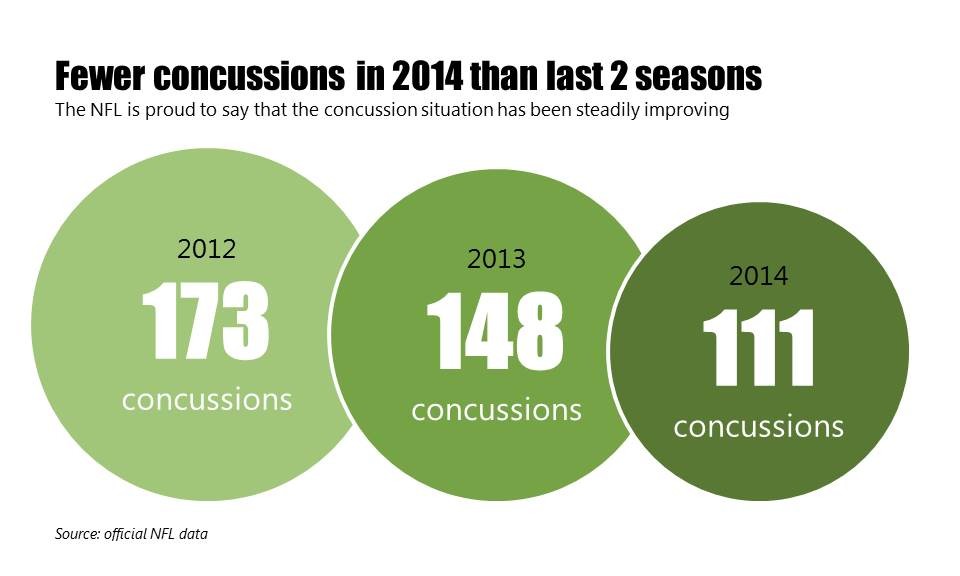PowerPoint Clip Art is Dead. Now What?
February 16, 20156 Steps to a Snazzier Title Slide
June 15, 2015Chris Borland made headlines last week when he announced, after one year in the NFL, he was retiring because the risk of concussions was too great. It was especially pertinent given March 2105 is Brain Injury Awareness Month. The NFL responded that “football has never been safer“.
And that got me thinking. How BAD is the concussion problem in the NFL? Is the risk too great, as Borland says? Or is it relatively safe, as the NFL wants us to believe?
But first, let’s appreciate what it means to suffer a concussion.
The long-term complications from concussions can include chronic migraines, fuzzy thinking, forgetfulness, seizures, early-onset Alzheimer’s, and depression, often leading to suicidal thoughts. One of the example is Andre Waters, a safety with the Philadelphia Eagles known for his punishing tackles, who shot himself at the age of 44, a few years after retiring from the NFL. Examiners studied his brain tissue and found it was like that of an 85 year-old dementia patient. Other studies have found that 76 of 79 brains of deceased NFL players also showed signs of the same degeneration. However, the NFL has always denied there is a proven connection between concussions and later brain degeneration.
Let’s start with the NFL’s position. They say that over the past three years, the number of concussions has been decreasing. And the data show they are right.
 But hold on. Whenever you look at timeline data, always be skeptical of the starting date. Because the story can change based on your starting date. If we go back to 2009, the first year PBS Concussion Watch started tracking official injury reports, we see that the concussion problem got progressively worse until 2012, and it is now abating. So, the NFL’s story is true, but only half of the story. (note: NFL reports different numbers than Concussion Watch).
But hold on. Whenever you look at timeline data, always be skeptical of the starting date. Because the story can change based on your starting date. If we go back to 2009, the first year PBS Concussion Watch started tracking official injury reports, we see that the concussion problem got progressively worse until 2012, and it is now abating. So, the NFL’s story is true, but only half of the story. (note: NFL reports different numbers than Concussion Watch).
But are these numbers good? Is 111 concussions in the NFL too high? Or “safe”? There are 32 teams and 53 players per team, for a total of 1,696 players. If 111 get a concussion, that’s 6.5%. That seems pretty low, I guess.
But it turns out that the chances of getting a concussion are different based on your position. In 2014, only 2% of quarterbacks got a concussion. But 14% of cornerbacks. 2% seems pretty low. 14% seems kinda high to me.
In fact, if you look at the trends by position, you see the percentage has decreased for offensive players, especially running backs, tight ends and wide receivers. That’s in part because of the NFL’s new rules protecting ball carriers from vicious tackles, especially helmet-to-helmet. But they have stayed stubbornly high for defensive players, especially cornerbacks, safeties and linebackers.
This shows the percentage chance of getting a concussion in a single season. But what if you have a 10-year career? Clearly, the chances of getting a concussion sometime during your career will be higher the longer you play.
Most players don’t last 10 years. According to the NFL, the average NFL career is 6 years. So, assuming you are a rookie starting in the NFL, what is the chance you will get a concussion sometime during your 6-year career? The numbers are more sobering.
Now we see the true extent of the NFL’s concussion problem. For the “speed positions” (the fastest players on the field), and especially those involved in the passing game, at least one-in-three will get a concussion during their career. If you are brave enough to be a cornerback or safety, one of every two players will get at least one concussion during their career.
So does the NFL have a concussion problem? That’s a normative question, based on what you think is “normal”.
But put the question this way: imagine there was a paint, and if you were exposed to it long enough there’s a 35% chance that the rest of your life will be complicated by depression, early-onset Alzheimer’s and suicidal thoughts. Would the government allow you to pain the walls of your workplace with this stuff?
Not likely. I’d say the NFL does have a concussion problem.
About the author: Bruce Gabrielle is author of Speaking PowerPoint: the New Language of Business, showing a 12-step method for creating clearer and more persuasive PowerPoint slides for boardroom presentations. Subscribe to this blog or join my LinkedIn group to get new posts sent to your inbox.




